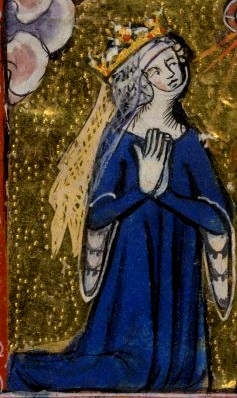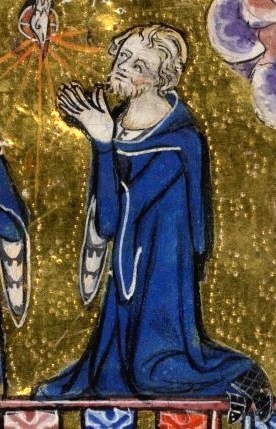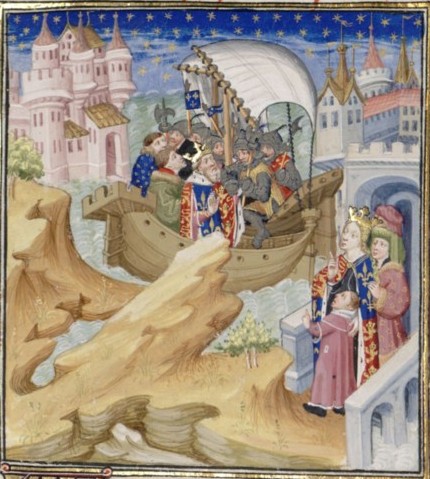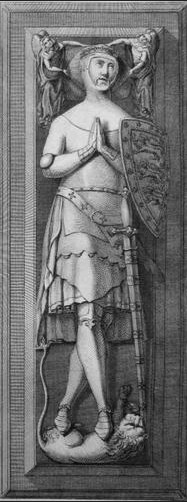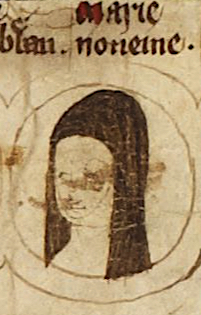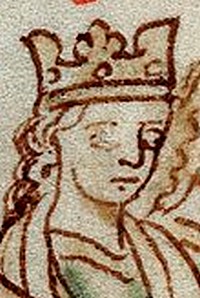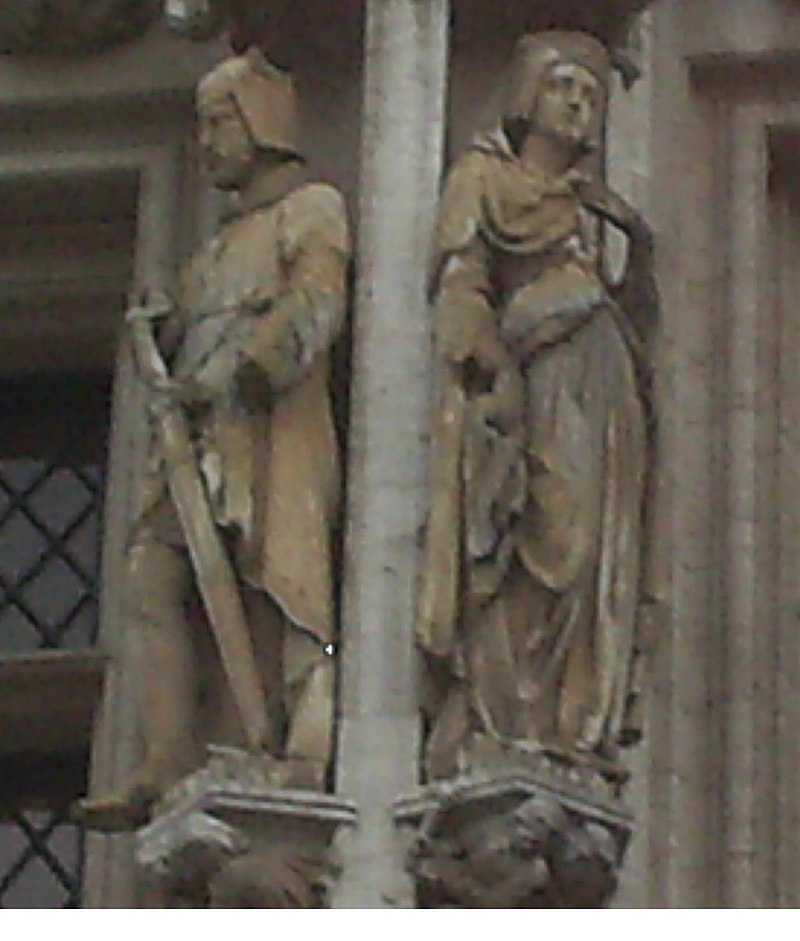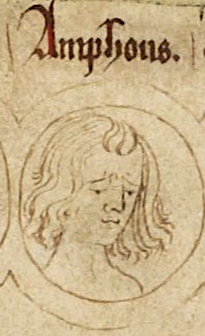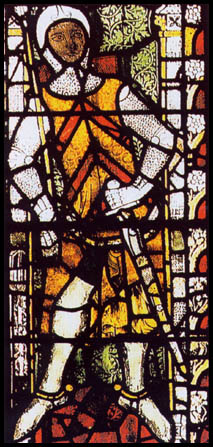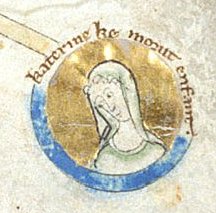by Susan Flantzer
© Unofficial Royalty 2022
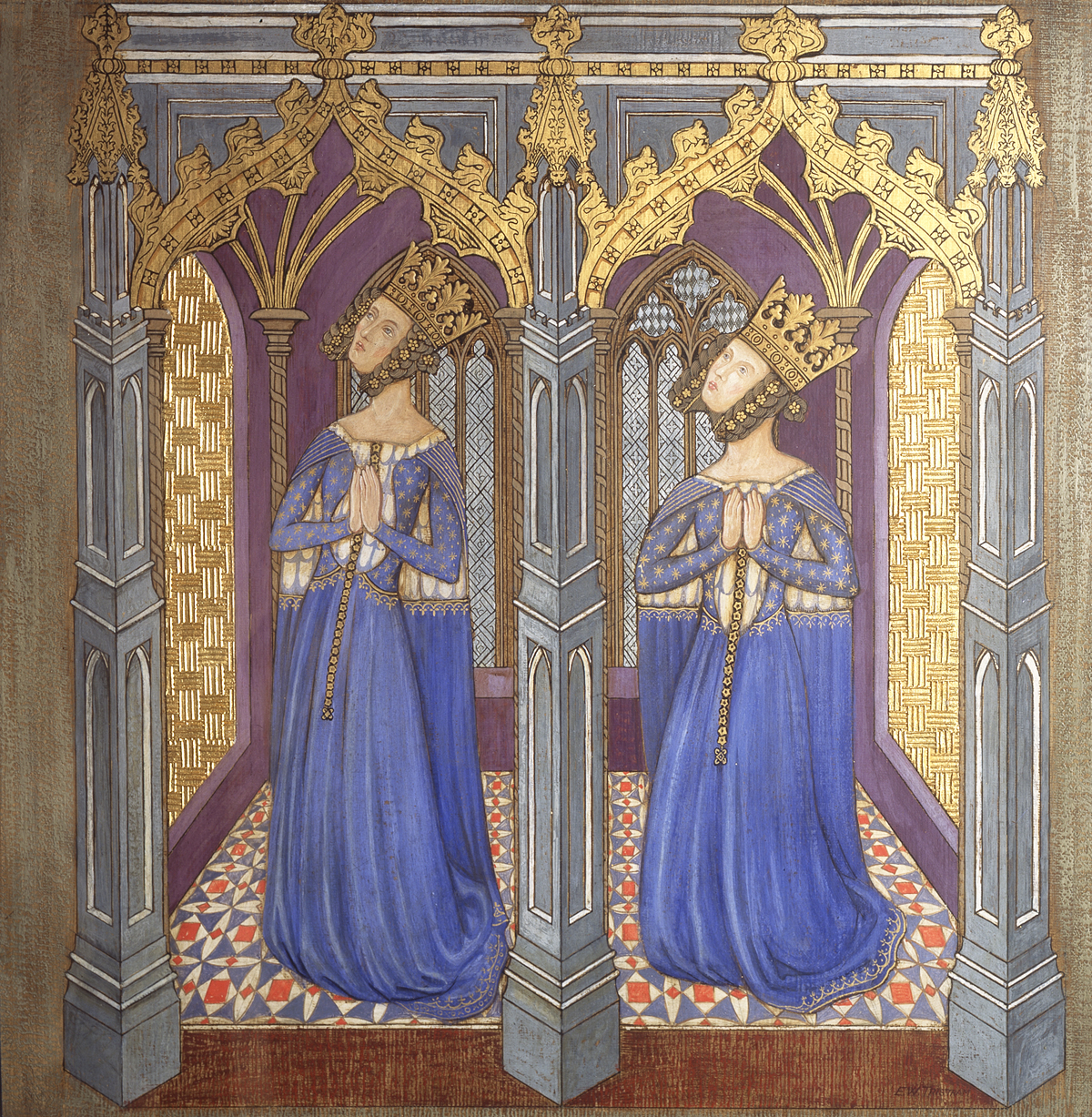
Philippa of Hainault, Queen of England & one of her daughters, probably Isabella, wall painting at St Stephen’s Chapel, Palace of Westminster; Credit – Wikipedia
Born on June 16, 1332, at Woodstock Palace in Woodstock, Oxfordshire, England, Isabella of England, Countess of Bedford, was the second of the fourteen children and the eldest of the five daughters of King Edward III of England and Philippa of Hainault. Her paternal grandparents were King Edward II of England and Isabella of France, for whom she was named. Isabella’s paternal grandparents were Willem I, Count of Hainault (also Count of Holland, Count of Avesnes, and Count of Zeeland) and Joan of Valois.
Isabella had thirteen siblings. Her brothers married into the English nobility, and it was their descendants who later battled for the throne in the Wars of the Roses. During the reign of the House of Plantagenet, their children were often identified by their place of birth, and so some of Isabella’s siblings were called “of <their birthplace>.
- Edward, Prince of Wales, the Black Prince (1330 – 1376), married Joan, 4th Countess of Kent, had issue (King Richard II of England)
- Joan of England (1333/1334/1335 – 1348), died of the plague on the way to marry Pedro of Castile
- William of Hatfield (born and died 1337)
- Lionel of Antwerp, 1st Duke of Clarence (1338 – 1368), married (1) Elizabeth de Burgh, 4th Countess of Ulster, had issue (2) Violante Visconti, no issue
- John of Gaunt, 1st Duke of Lancaster (1340 – 1399), married (1) Blanche of Lancaster, had issue including King Henry IV of England (2) Infanta Constance of Castile, had issue (3) Katherine Swynford (formerly his mistress), had issue
- Edmund of Langley, 1st Duke of York (1341 – 1402), married (1) Infanta Isabella of Castile, had issue (2) Joan Holland, no issue
- Blanche of the Tower (born and died March 1342)
- Mary of Waltham (1344 – 1362), married John V, Duke of Brittany, no issue
- Margaret of Windsor, Countess of Pembroke (1346 – 1361), married John Hastings, 2nd Earl of Pembroke, no issue
- Thomas of Windsor (1347 – 1348), died of the plague
- William of Windsor (born and died 1348), died of the plague
- Thomas of Woodstock, 1st Duke of Gloucester (1355 – 1397), married Eleanor de Bohun, had issue
The family’s main home was Woodstock Palace in Oxfordshire, England. It was Isabella’s mother’s favorite residence and the birthplace of Isabella and three of her siblings. Isabella and her siblings had their own household, with many servants. As a child, Isabella, her brother Edward, and her sister Joan, the three eldest children, were sent to live in the household of Sir William de St. Omer, Lord of Brundale. It was common for royal and noble children to be raised for a period of time in another household.
When Isabella was three years old, her father unsuccessfully attempted to negotiate a marriage for her with Pedro I, the future King of Castile and León. In 1345, Isabella’s sister Joan was betrothed to the same Pedro but in 1348, as fourteen-year-old Joan traveled from England to Castile, she became ill with the plague and died. Over the years, Isabella had several other possible betrothals but none came to fruition. In 1351, a marriage had been arranged with Bernard d’Albret, son of Bernard Ezi II, Lord of Albret who held land in Gascony, now in France. As the ship was about to depart for France, Isabella changed her mind, and the marriage was called off. The unmarried Isabella was actively involved in court life and enjoyed watching tournaments and taking part in hunts. King Edward III granted his unmarried daughter English land including, in 1355, the control of Burstall Priory in Yorkshire. In 1358, Eleanor was granted an annual income of a thousand marks.
At the age of thirty-three, in 1365, Isabella married for love. The French nobleman Enguerrand VII, Lord of Coucy was one of the forty hostages from the French high nobility sent to England in 1360 during the Hundred Years’ War in exchange for the release of King Jean II of France. Seven years younger than Isabella, he was the son and heir of Enguerrand VI, Lord of Coucy and Catherine of Austria. In London, Enguerrand became acquainted with King Edward III and his unmarried daughter Isabella. The couple fell in love. Edward III agreed to the marriage and granted him the titles Earl of Albemarle and Earl of Bedford.
On July 27, 1365, Isabella and Enguerrand were married at Windsor Castle amid festivity and magnificence. Isabella wore the jewels her father, mother, and brothers gave her as a wedding present. King Edward III’s wedding present to his new son-in-law Enguerrand was his release as a hostage without paying a ransom.

Ruins of the Château de Coucy; Credit – By CJ DUB – Own work, Attribution, https://commons.wikimedia.org/w/index.php?curid=2699065
Four months after the wedding, Isabella and Enguerrand traveled to Enguerrand’s home, the Château de Coucy in Coucy-le-Château-Auffrique, Lordship of Coucy, now in France. In April 1366, Isabella gave birth to her first daughter in Coucy. Throughout her married life, Isabella never felt quite at home in Coucy. Whenever Enguerrand had to be away for extended periods, she would return to England. The couple’s second daughter was born in Eltham Palace in London, England in 1367.
Isabella and Enguerrand had two daughters:
- Marie de Coucy, Countess of Soissons (1366 – 1405), married Henri of Bar, Lord of Marle, Marquis de Pont-à-Mousson, had two sons
- Philippa de Coucy (1367 – 1411), married Robert de Vere, Duke of Ireland, Marquess of Dublin, 9th Earl of Oxford, a favorite of Philippa’s first cousin, King Richard II of England, no children
Three months after the birth of their second daughter, Isabella and her husband returned to Coucy. When the Hundred Years’ War between England and France resumed in 1368, Enguerrand VII faced a dilemma as he was a vassal of the King of France and the son-in-law of the King of England. He decided not to participate in any battles of the Hundred Years’ War. However, Enguerrand continued to serve the King of France as a military commander and was often away from home.
In 1376, Isabella was created the second Lady of the Garter. Her mother Queen Philippa had been created the first Lady of the Garter in 1369. The Order of the Garter was founded in 1348 by Isabella’s father King Edward III and is the oldest and most senior order in the United Kingdom.
In April 1377, Isabella was summoned to England because of the ill health of her father King Edward III. She was at his deathbed when he died on June 21, 1377. Because Isabella’s elder brother Edward, Prince of Wales, the Black Prince had died in 1376, his ten-year-old son succeeded as King Richard II. After the coronation of Richard II, Enguerrand decided to cut all ties to England and only serve the French king, effectively ending his marriage with Isabella. Enguerrand returned to France, never to see Isabella again. Isabella remained in England with her younger daughter Philippa while her older daughter Marie continued living in France.
Isabella died either in April 1379 or sometime between June 17 and October 5, 1382, aged 47 or 50. She was buried in Christ Church Greyfriars in London, England. Several other female family members were also buried there: her paternal aunt Joan of The Tower, Queen of Scots; her paternal grandmother Isabella of France, Queen of England; the second wife of her great grandfather King Edward I, Margaret of France, Queen of England; and her great-great-aunt, the daughter of King Henry III, Beatrice of England. The graves and the tombs at Christ Church Greyfriars have been lost or destroyed. The monastery associated with Christ Church Greyfriars was dissolved in 1538 during the Dissolution of the Monasteries. The buildings, including the church, suffered heavy damage. Tombs disappeared, sold for their marble and other valuable materials, and monuments were defaced. The original Christ Church Greyfriars was destroyed during the 1666 Great Fire of London. The church was rebuilt but was mostly destroyed by bombing during World War II. It was decided not to rebuild the church and the ruins are now a public garden.
This article is the intellectual property of Unofficial Royalty and is NOT TO BE COPIED, EDITED, OR POSTED IN ANY FORM ON ANOTHER WEBSITE under any circumstances. It is permissible to use a link that directs to Unofficial Royalty.
Works Cited
- Flantzer, Susan. (2015) King Edward III of England, Unofficial Royalty. Available at: https://www.unofficialroyalty.com/king-edward-iii-of-england/ (Accessed: November 23, 2022).
- Mortimer, Ian. (2006) The Perfect King: The Life of Edward III, Father of the English Nation. London: Vintage Books.
- Weir, Alison. (1989) Britain’s Royal Families: The Complete Genealogy. London: Vintage Books.
- Williamson, David. (1996) Brewer’s British royalty: A Phrase and Fable dictionary. London: Cassell.

